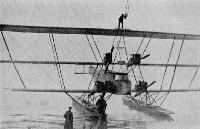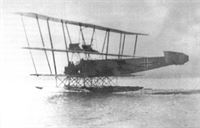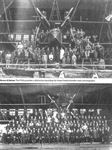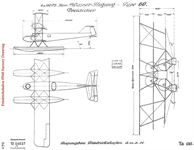
Описание
Страна: Германия
Год: 1918
O.Thetford, P.Gray German Aircraft of the First World War (Putnam)
Friedrichshafen FF 60
Powered with, four 160 h.p. Mercedes D III engines, the FF 60 was a giant experimental triplane, built during 1918, and carried a crew of four. Intended for long-range patrol duties, a defensive armament of three to four Parabellum machine-guns was carried.
Описание:
- O.Thetford, P.Gray German Aircraft of the First World War (Putnam)
- J.Herris Friedrichshafen Aircraft of WWI (A Centennial Perspective on Great War Airplanes 21)
Фотографии
-
O.Thetford, P.Gray - German Aircraft of the First World War /Putnam/
Friedrichshafen FF 60
-
J.Herris - Friedrichshafen Aircraft of WWI /Centennial Perspective/ (21)
Fdh FF60 (1918). On February 15, 1918, the Reichs-Marine-Amt (R.M.A.) ordered four-engine seaplanes with 4 x 160 hp Mercedes D.III engines as long-range reconnaissance aircraft. The engines had to be maintainable in flight and the propeller clearance to the water surface had to be 80 cm. It was also required that a flight altitude of 1,000 m be maintained with three functioning engines and a full payload. Seaworthiness up to sea state force 4 was also required, and in the event of an emergency landing, it had to be possible to jettison half the fuel load. The first aircraft had just been completed at the end of the war (November 11, 1918), but was only allowed to undertake taxi tests on the instructions of the R.M.A.
The FF60 during testing on Lake Constance. The FF60 was completed just as the war ended but Friedrichshafen was given permission to test fly the aircraft.
In stark contrast to 1918 German fighter prototypes, the Friedrichshafen FF60 prototype long-range maritime reconnaissance aircraft of late 1918 was a triplane. The triplane wings enabled large wing area for high lift with moderate wing span to keep the wingtips out of the water during operations. Its four 160 hp Mercedes D.III engines were arranged as near to the centerline as possible to minimize asymmetric thrust in case of engine failure. Extensive strut bracing contributed to its high drag. -
J.Herris - Friedrichshafen Aircraft of WWI /Centennial Perspective/ (21)
The FF60 during testing on Lake Constance.
The Mercedes D III and D IIIa engines were widely used in fighters. One of the most unusual types to use the D IIIa was the Friedrichshafen FF60, a prototype long-range maritime reconnaissance floatplane. It appears to have been developed to the same requirement as the Gotha WD27. The FF60 was completed just as the war ended and was test flown in November 1918. The D IIIa may have been chosen for its reliability given the FF60's design role. -
J.Herris - Friedrichshafen Aircraft of WWI /Centennial Perspective/ (21)
The FF60 being launched via crane for testing on Lake Constance.
-
J.Herris - Friedrichshafen Aircraft of WWI /Centennial Perspective/ (21)
The FF60 provides a distinctive backdrop for these Friedrichshafen team photographs.
-
J.Herris - Friedrichshafen Aircraft of WWI /Centennial Perspective/ (21)
Friedrichshafen FF60 Factory Drawing






